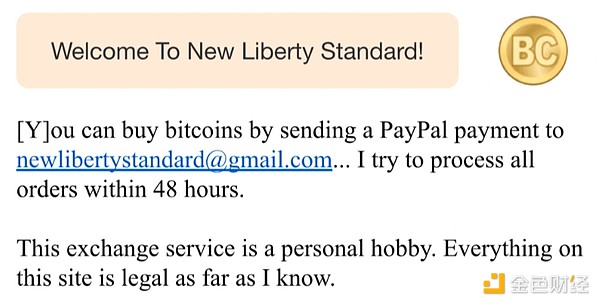Author: Matt Hougan, Chief Investment Officer of Bitwise; Translated by: 0xjs@黄金财经
I first heard about Bitcoin in February 2011.
At the time, I was working at ETF.com, managing a team of young financial analysts and operating the world's first ETF data and analysis service. We met every week to discuss what was happening in the market. In February 2011, the price of Bitcoin broke through $1 for the first time, and one of my analysts mentioned this historic "dollar threshold." He then led a fascinating discussion about what Bitcoin is, how it works, and what it might become.
If I had invested $1,000 in Bitcoin after that meeting, the investment would be worth $88 million today. However, I left the office at the time and went to buy a cup of coffee.
I share this story because everyone - really everyone - feels this way. We all wish we had bought into Bitcoin sooner.
But what we miss in these stories is that there was a lot of risk involved with Bitcoin at the time.
For example, on the day I attended that $1 Bitcoin conference, the largest cryptocurrency exchange in the world was New Liberty Financial. Here are their terms of service.¹

In hindsight, it’s easy to say I should have bought $1,000 of Bitcoin. But at the time, that meant wiring $1,000 to a random PayPal account. Add to that the custody, regulatory, technological, and government risks…putting $1,000 on Bitcoin in 2011 was a huge gamble.
I’m sharing this story now for two reasons: first, so you don’t have to beat yourself up for missing out on investing in Bitcoin, and second, so you can believe that things are different now.
In fact, I believe that today — right now — is the best time ever to buy Bitcoin in risk-adjusted terms.
We’ve just eliminated the last major existential risk to Bitcoin
Every investment involves weighing risk against reward. A lottery ticket could turn $1 into $1 billion, but your expected return is zero.
In the early days of Bitcoin, it was a bit like a lottery: there was a huge upside, but the risks were equally huge.
For example, when Bitcoin was first launched, there was no guarantee that it would even work. Yes, the white paper is brilliant. Logically, it seems like it should work. But there have been many attempts to build electronic cash systems before Bitcoin, and they all failed. (For an example, see this 1997 NSA paper, “How to Mint Money: The Cryptography of Anonymous Electronic Cash”.)
But in Bitcoin’s early days, there were other significant risks beyond the technology itself. For years, trading was a risk factor—early exchanges were either unreliable or plagued by low volumes and poor operations—until Coinbase was founded in late 2011.
For a while, custody was a risk factor, too—until established blue-chip companies like Fidelity began offering self-custody and institutional custody services.
In the early days of Bitcoin, there were legitimate concerns about money laundering, criminal activity, regulatory standards, mining centralization, and more.
The amazing thing about Bitcoin is that it has slowly but surely eliminated each of these major existential risks over time.
The launch of a Bitcoin spot ETF in January 2024 will allow us to cross another major hurdle, providing regulatory clarity for US institutional investors interested in entering this space.
But even after the launch of the ETF, there is one major existential risk that always lingers in my mind: What if the government bans Bitcoin?
US Strategic Bitcoin Reserve
This is the question I get asked every time I’m at a conference, “What keeps you up at night? ” I always ask when I ask the question.
I always wonder why the United States, which famously confiscated privately held gold in 1933 to replenish its coffers, would allow Bitcoin to grow to a size that threatens the dollar’s status?
To be honest, I didn’t know the answer at the time.
When pressed on stage, I always remind people that the US government “bought” gold from the public in 1933: I would say that if Bitcoin grew to a size that challenged the dollar, your investment would probably have made a lot of money.
That’s the best answer I can give.
But earlier this month, President Trump signed an executive order establishing the U.S. Strategic Bitcoin Reserve. Just like that, the last major existential risk facing Bitcoin disappeared before my eyes.
A lot of people are wondering why the United States would do this. Hedge fund AQR “If cryptocurrencies are a viable long-term competitor to the dollar, why on earth are we promoting this direct competitor to our status as the world’s reserve currency?” Cliff Asness, founder of Capital, wrote immediately after Trump signed the executive order.
The answer, of course, is that Bitcoin is better than the alternatives. The best case scenario for the United States is that the dollar continues to remain the world’s reserve currency. But if the day comes when the dollar’s status is at risk, we are better off choosing Bitcoin as an alternative than choosing something like the renminbi.
Here’s what I didn’t expect at first: Of course the United States will accept Bitcoin. It is the best fallback on the market.
What this means for investors
Note 1: I created this image based on the graphics and terms of service from the original website, which you can view here (https://web.archive.org/web/20100301174241/http://newlibertystandard.wetpaint.com/page/Exchange+Rate).
 Miyuki
Miyuki
 Miyuki
Miyuki Alex
Alex Brian
Brian Weiliang
Weiliang Joy
Joy Miyuki
Miyuki Alex
Alex Brian
Brian Weiliang
Weiliang Miyuki
Miyuki